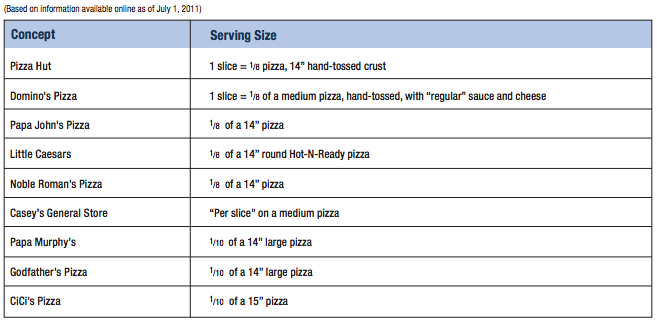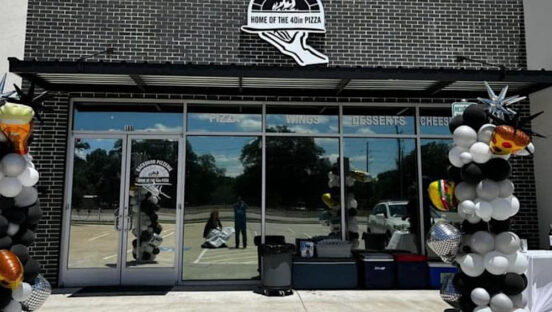 As I began to write last month’s article about menu labeling, I thought it would be easy to include examples of what pizza concepts should do to properly analyze their pizza and figure out the details of the pieces and parts. However, in my research to see what’s out there among the leading pizza concepts for calorie counts, nutritionals and how to configure a simple pizza, I found that the current situation is anything but simple. I was quite surprised by the lack of standardization; evidently, this process is more difficult than it looks, and various kitchens have come up with various procedures. The confusion and variance most likely arises from people making their best efforts, and not from any deliberate attempts at deception.
As I began to write last month’s article about menu labeling, I thought it would be easy to include examples of what pizza concepts should do to properly analyze their pizza and figure out the details of the pieces and parts. However, in my research to see what’s out there among the leading pizza concepts for calorie counts, nutritionals and how to configure a simple pizza, I found that the current situation is anything but simple. I was quite surprised by the lack of standardization; evidently, this process is more difficult than it looks, and various kitchens have come up with various procedures. The confusion and variance most likely arises from people making their best efforts, and not from any deliberate attempts at deception.
Setting Industry Standards
Current proposals from the Food and Drug Administration (FDA) would require calorie counts to show one serving as equal to an entire pizza. However, since there is no industry-standard serving size yet, I uncovered a clear trend that represents convergence. A “standard regular crust” that’s 14” in diameter, with moderate amounts of sauce and cheese added, is the baseline reference, and the nutritionals are fairly easy to compute (even by hand!). Slice the finished pie into eight pieces, and you can declare one slice to be one serving. The listed per-serving data is therefore 1/8 of the whole pie. This appears to be a reliable common practice for the industry to pursue in the near future. Obviously, this formula ignores the complexity of different toppings and combinations, but we have to start somewhere.

I created the table on the previous table to compare the various methods of how leading pizza concepts report their nutritional data; you’ll see that most of them follow the 14” standard introduced above.
Papa Murphy’s Pizza (papamurphys.com) calls a serving 1/10 of a pie (the family size), and those per-slice numbers still come out relatively high. I’m not sure how many slices I personally cut from a PM pizza, but I do not think one would fi l me up or feel like a full serving. Also, for CiCi’s Pizza (cicispizza.com), the serving size is 1/10 of a 15” pizza. Once again, that seems like a small (and not quite credible) slice for the average adult.
For me, the Domino’s Pizza (dominos.com) nutritional information was by far the hardest to figure out; it listed every single part of the pizza as a separate item. Even with a calculator, it was difficult. The information lists everything numbered out for an entire pizza, but calls a serving 1/8 of a medium pizza, so you have to add everything up and then divide by eight to determine perserving information.
What’s a Serving?
It would help the entire industry if the people who analyze pizzerias’ menus and nutritionals all played by the same rules. For me, as a consumer, at most of the concepts I looked at for this article, it would take a few slices to constitute a full serving and satisfy without being gluttonous. The FDA does have serving
sizes and regulations for the retail end of the industry, and I think adopting those same regulations for restaurants is the best practice for pizza restaurants and their customers. (If you’re interested in learning more, Google “FDA RACC.”)
Even for industry segments with well-known container sizes, there’s a lot of room to transform the numbers. For example, the beverage industry has a history of making the per-serving numbers look good by listing a serving size as “X ounces” with multiple servings per container, such as “2.5 servings” per container. Maybe this is the new math, but it seems unnecessarily complex.
I’ve been around a number of great industry people during the last few weeks and had many different conversations one-on-one with owners, operators and others who have a strong interest in the continued success of their chains. It became abundantly clear to me that most, if not all, want to do the right thing: present the numbers clearly, honestly and with the utmost confidence.
It was also clear that most concepts are challenged by trying to know how to properly provide this source of information. And that’s where a trained staff member or hired service will be worth their weight in mozzarella!
Today’s diners are much more informed and knowledgeable about nutrition. They will request your numbers, and if they see results that seem too good to be true, they’ll know they are just that. Plus, you can win more loyal customers through transparency and accuracy. Above all, my advice: For anything you put your name on, you need to be ready to stand behind it—even a calorie count. It’s part of your brand, your concept and your reputation, so this is not the area to pinch pennies.












